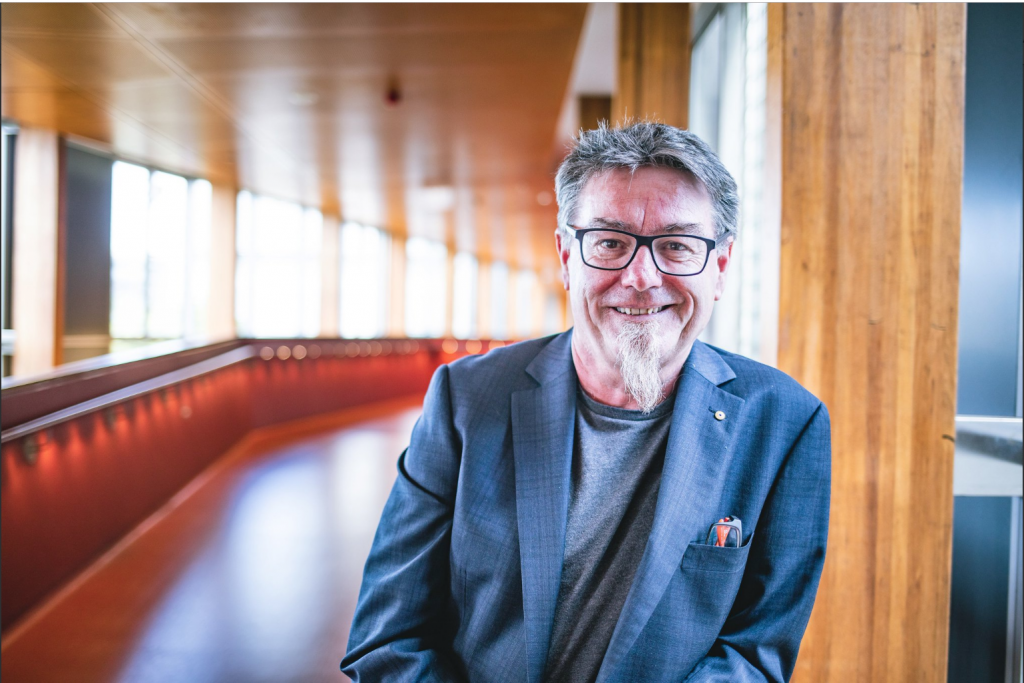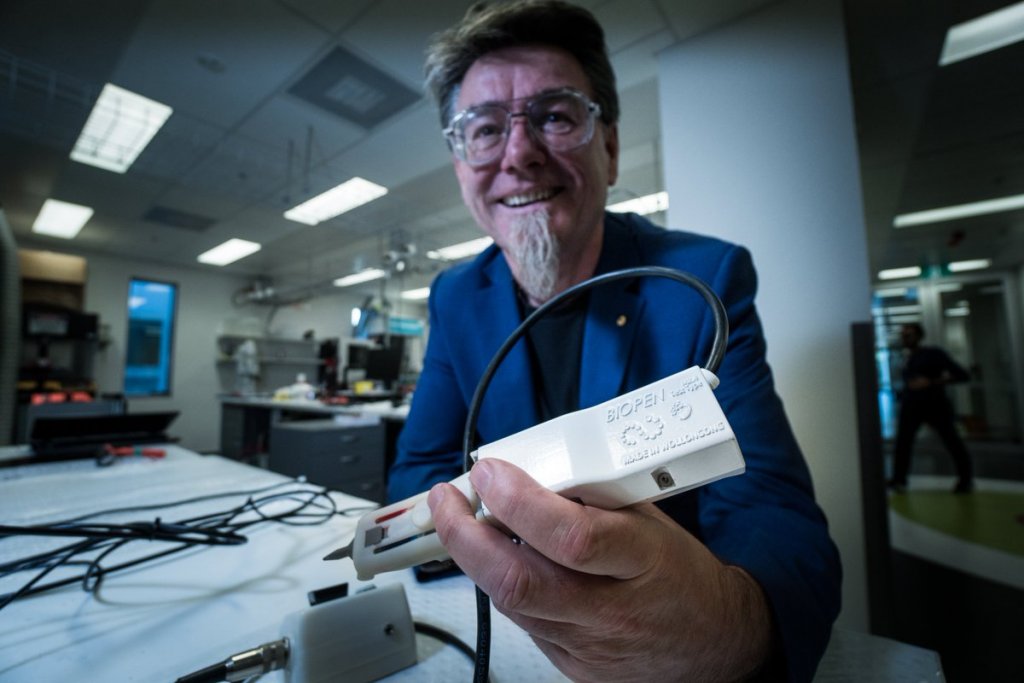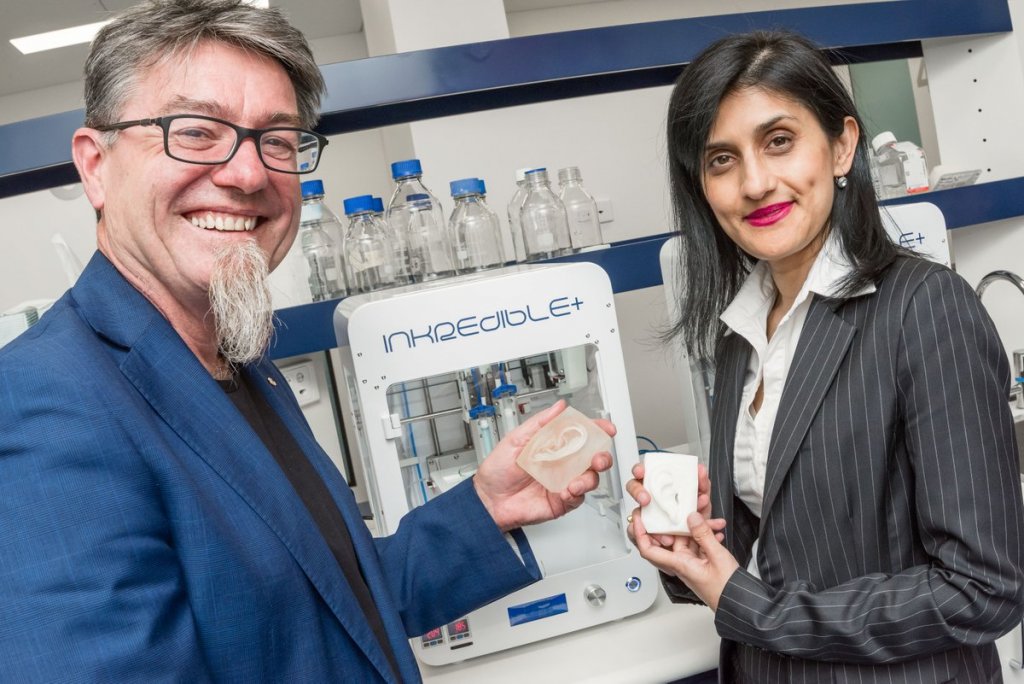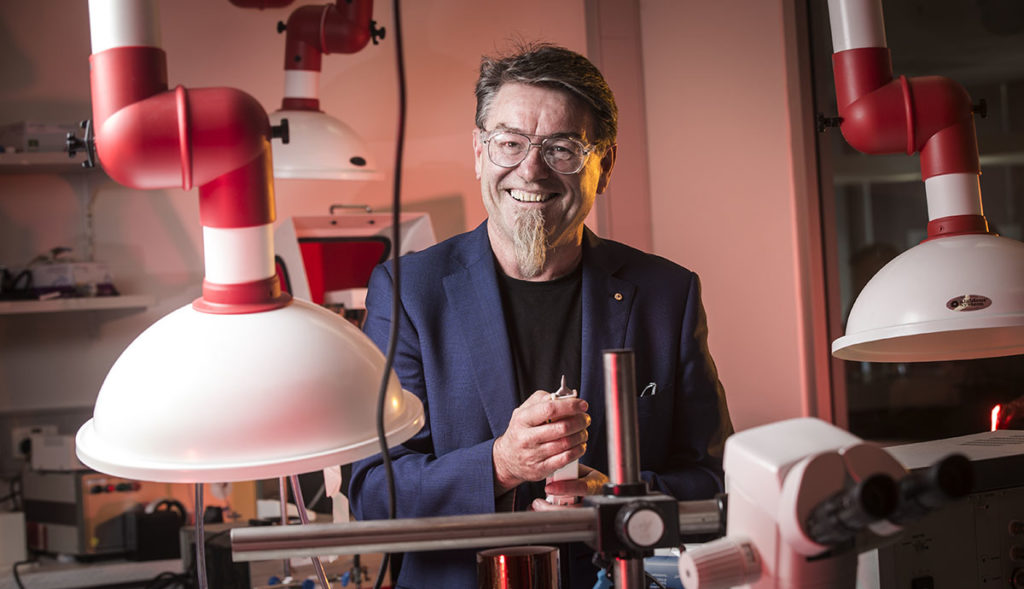 In a race to combat very specific medical challenges, Gordon Wallace has developed groundbreaking and bespoke advances in bioprinting, both in specialized 3D printing devices and customized bioinks. Along with fellow researchers at the University of Wollongong (UOW), in Australia, working with clinicians and institutions, they seek to find solutions for rare conditions, like microtia, schizophrenia, epilepsy, as well as for more common afflictions, including corneal ulcerations and damaged cartilage.
In a race to combat very specific medical challenges, Gordon Wallace has developed groundbreaking and bespoke advances in bioprinting, both in specialized 3D printing devices and customized bioinks. Along with fellow researchers at the University of Wollongong (UOW), in Australia, working with clinicians and institutions, they seek to find solutions for rare conditions, like microtia, schizophrenia, epilepsy, as well as for more common afflictions, including corneal ulcerations and damaged cartilage.
A distinguished professor at UOW, Wallace has been working in bioprinting for the past 25 years with a background in materials science. His first foray into biotechnology was developing new electrode materials for Graeme Clark’s pioneer multi-channel Cochlear Implant for severe-to-profound deafness, and in developing those new materials Wallace realized that conventional fabrication wasn’t good enough, which quickly sparked an interest in developing new 3D printing techniques.
“We have been fortunate because all of our projects and research have been driven by our incredible clinician network throughout the country,” explained Wallace to 3DPrint.com during an interview. “This is a highly interdisciplinary field, so through collaborative efforts bioprinting has advanced a lot. Our collaboration spans from timely producers of materials, like seaweed farmers–we extract the molecules form this type of algae and use it as a source of our bioink–right through the materials processing in mechatronic engineering, designing and building applications with cell technologists and medical specialists.”
Wallace has been identifying and customizing materials and bioprinters to deliver solutions like the BioPen for cartilage regeneration, the iFix Pen to treat corneal ulceration, the bioprinter 3D Alek to reproduce the complex geometry of an external ear, leading a project to reproduce brain cells, and he even developed a specialist Pancreatic Islet Cell Transplantation (PICT) bioprinter. Most of the developments are taking place at the ARC Centre of Excellence for Electromaterials Science (ACES), where Wallace is Executive Director; the Translational Research Initiative for Cellular Engineering and Printing (TRICEP), which also has the expert as Director; and the Australian National Fabrication Facility (ANFF) Materials Node, based at the UOW Innovation Campus. The university and its partner institutes have quickly become some of the go-to-places for medical bioprinting advances. TRICEP is a 100% owned initiative of the UOW and can commercialize opportunities in 3D bioprinting including printer manufacturing, biomaterials, bioinks, and material-cellular combinations to address significant industry challenges that require an exclusive, tailored solution; it even houses a range of additive manufacturing technologies, including the highest resolution metal printer in Australia and the country’s leading biofabrication capability to develop biomaterials.
Back in 2014, Wallace, along with researchers at the Department of Surgery at St Vincent’s Hospital Melbourne, used stem cells to build 3D structures to encourage the formation of cartilage in human tissues, claiming they were on the cusp of reaching their goal: “true cartilage regeneration.” Soon after, a team led by Wallace developed the BioPen, which allows surgeons to use a hand-held co-axial 3D printer pen filled with stem cell ink to ‘draw’ new cartilage into damaged knees in the middle of a surgical procedure, providing practitioners with greater control over joint repairs, and reduce surgery time.
“The BioPen will eventually repair damaged bones, muscles and tendons, and reduce the need for joint replacements by regenerating cartilage, which we have already done in preliminary studies in animals. During this year and the next, we hope to lead some preclinical studies, and if those turn out to be successful the plan is to move into clinical trials with Professor Peter Choong, Director of Orthopaedics at St Vincent’s Hospital Melbourne. Repairing the cartilage in the knee is pretty huge in Australia because it is a sports oriented country with a big demand, especially in younger patients that might have suffered a sports-related injury, and thanks to this, they could avoid osteoarthritis later in life,” explained Wallace.
Soon, other clinicians became interested in the utility of the BioPen, thinking it could be applicable to other medical disciplines, such as for treating wounds and ulcers in the eye. Gerard Sutton, Ophthalmic Surgeon and Professor of Corneal and Refractive Surgery at the Save Sight Institute with the University of Sydney’s School of Medicine, noticed what Wallace was doing and thought that he could print a different kind of ink directly into the eye. They soon started working together to revolutionise the treatment of corneal ulceration by developing the iFix Pen, which delivers a special bioink formulation that has the capacity to facilitate healing and prevent infection in treating the disease, which causes severe eye pain, visual morbidity and visual loss, and accounts for 55,000 hospital admissions in Australia every year. The exciting new collaborative corneal bioengineering program started in 2017 and was awarded over 780 thousand US dollars for research and development. Animal testing is already underway.
“At the lab we use both stem cells and biomaterials. The source of the cells varies depending on the clinical application that we are pursuing, as well as the different kinds of combinations of biomaterials that constitute the bioink wich also depends upon the patient. The choice is driven by the clinical application, while optimizing performance in that specific biological environment requires a different combination of cells and materials for bioinks,” Wallace continued.
Another very specific project is the development of a custom 3D bioprinter dedicated specifically to treating microtia, a congenital deformity that results in an underdeveloped external ear. Named 3D Alek, the machine was recently installed at the Royal Prince Alfred Hospital (RPA) in Sydney, since it was done in collaboration with associate professor and Ear, Nose and Throat surgeon at RPA Payal Mukherjee, who treats a lot of kids who have the disease. According to Wallace, Mukherjee’s vision was to create a 3D printed external ear. Ultimately, the goal is to 3D print a living ear using a patient’s own stem cells, something the team is developing now.
“But bioprinting is not without some challenges, which are still in optimizing the cells and material combinations for particular applications. Also, a general challenge in 3D printed structures for tissue regeneration is the ability to encourage vascularization of that structure so that bigger defects can be treated. I believe that it is a challenge that many groups around the world, including our own, are concerned about,” suggested Wallace.
Challenge or no challenge, Wallace is hard at work. At the UOW Intelligent Polymer Research Institute (IPRI), which he founded and also directs, Jeremy Crook, Associate Professor at UOW and ACES, is leading a project to reproduce brain cells through bioprinting, to study conditions like schizophrenia, epilepsy, and depression.
“Driven by clinical need, we are really interested in how diseases like epilepsy and schizophrenia develop, and one way to try and get some insights into that is to be able to 3D bioprint stem cells from the patient and try to create functional neural networks on the bench to understand how those diseases develop, as well as to gain insight into that little bit of tissue we created with bench research to test interventions, such as pharmaceutical.”
A few years back Crook and Wallace indicated that many neuropsychiatric disorders result from an imbalance of key chemicals called neurotransmitters, which are produced by specific nerve cells in the brain. Defective serotonin and GABA-producing nerve cells are implicated in schizophrenia and epilepsy while defective dopamine-producing cells are involved in Parkinson’s disease, so the team started using 3D printing and bioink to make neurones involved in producing GABA and serotonin, as well as support cells called neuroglia.
More recently, ACES researchers developed a bioprinter to help people with Type 1 diabetes: the Pancreatic Islet Cell Transplantation (PICT) 3D Printer, which works by delivering insulin-producing islet cells and is now in use at the Royal Adelaide Hospital (RAH), where Wallace and his team collaborated with RAH Professor of Medicine Toby Coates. They are planning to improve the effectiveness of islet cell transplants by encapsulating donated islet cells in a 3D printed structure, to protect them during and after transplantation. But that’s not all: many more projects are on the way, including wound healing with Chris Baker, head of dermatology at St Vincent’s Hospital Melbourne working with ACES on clinical trials; printed structures to understand airway collapse and prevention with Stuart MacKay, surgeon and Clinical Professor in Otolaryngology and Head and Neck Surgery at UOW; and even bioprinting in space, which is something Wallace says they “were recently approached about”.
“We just started to think about the ability to 3D print and create things on demand in remote locations, like space, it is an ideal application and something we are very interested in pursuing. For now, I have no real experience about how microgravity will affect bioprinting, but what an exciting experiment that would be,” claimed Wallace.
According to the expert, it has taken a while to build the global collaborative network they now have, but it all seems to be coming to fruition, even some of the more complex aspects of bioprinting, like discussions about regulatory issues, something Wallace is quite involved in, as well as the engagement in ethical issues that might arise.
“In this area, the Therapeutic Goods Administration (TGA) has been very proactive in engaging with the research, commercial and clinical community in order to try to formulate an appropriate regulatory framework that can accommodate 3D bioprinting in Australia. They are aware that the technology is moving very fast, so they want to make sure that everything is in place,” continued Wallace.
As part of the thriving academic environment at UOW, Wallace is a professor of post-graduate courses, where he noticed an increase in student interest in STEM careers and biotechnology for the last few years.
“3D printing has already revolutionized the connections between science, engineering and mathematics and our ability to be incredibly creative and make new structures. But although our courses are in high demand and even our online platform to learn about 3D printing of body parts has been popular with over 30.000 students, I still think there will be a gap between the demand and supply of professionals to fill the biotechnology positions needed for future jobs,” Wallace stated. “There is a big gap at the moment, and it will take many years to recover, so we need to engage children in the early years of school, all the way through to university.”
[Images: UOW, ACES, Vision Eye Institute]“Today I can say that what really changed in the last five to ten years of bioprinting is the convergence of discoveries in material science, with advances in fabrication, particularly 3D printing that has really picked up the pace. We have seen more progress in the last five years than we did 15 years before that, and I think we will see incredible progress in the coming decade as that convergence matures and, particularly, as the clinical teams around the world realize what the possibilities are now in collaboration with the appropriate science and engineering groups. I’m sure many more specific challenges will come to the floor and that we will be able to meet them because of this convergence,” he concluded.
Subscribe to Our Email Newsletter
Stay up-to-date on all the latest news from the 3D printing industry and receive information and offers from third party vendors.
You May Also Like
Gorilla Sports GE’s First 3D Printed Titanium Cast
How do you help a gorilla with a broken arm? Sounds like the start of a bad joke a zookeeper might tell, but it’s an actual dilemma recently faced by...
Nylon 3D Printed Parts Made More Functional with Coatings & Colors
Parts 3D printed from polyamide (PA, Nylon) 12 using powder bed fusion (PBF) are a mainstay in the additive manufacturing (AM) industry. While post-finishing processes have improved the porosity of...
$25M to Back Sintavia’s Largest Expansion of Metal 3D Printing Capacity Since 2019
Sintavia, the digital manufacturing company specializing in mission-critical parts for strategic sectors, announced a $25 million investment to increase its production capacity, the largest expansion to its operations since 2019....
Velo3D Initiates Public Offering in a Bid to Strengthen Financial Foundations and Drive Future Growth
Velo3D (NYSE: VLD) has been among a number of publicly traded 3D printing firms that have attempted to weather the current macroeconomic climate. After posting a challenging financial report for 2023,...





































